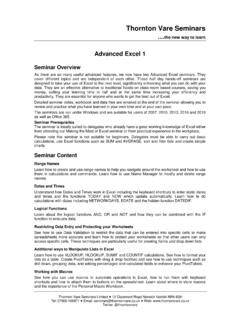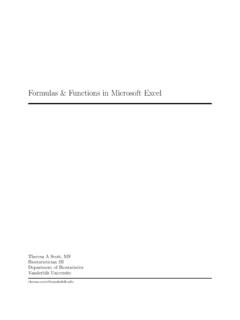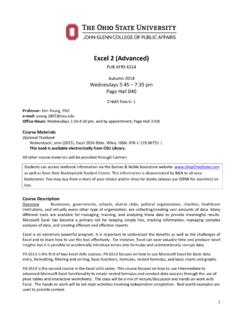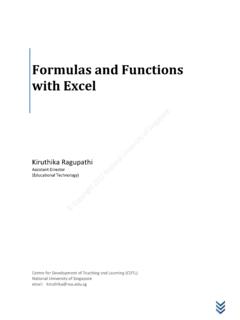Transcription of !!Advanced!Excel! Formulas!:!Functions!!
1 1 advanced excel Formulas : Functions Being able to work with excel Formulas can take your experience with the program to a new level. Formulas are the basic foundation of excel . For the beginning of the class, we are going to review the basics of formulas. Formulas are the ways you can calculate cells, numbers, etc. in your workbooks. Formula Operations: + Addition =1+1 - Subtraction =1- 1 * Multiplication =3*3 / Division =6/2 ^ Exponent =3^4 % Percent =20% (Divides by 100) =SUM Prefix Variety of prefixes to perform a function Order of Operations 1.
2 Parentheses (Everything in parentheses) =1+1(2+2) 2. Percent =1+1/20% 3. Exponents =1+1*2^3 4. Division/Multiplication =1+1+2*3 5. Addition/Subtraction =1+1 Relative vs. Absolute Relative =A1 Information can change Absolute =$A$1 Information cannot change Mixed =$A1 Only column A does not change Use absolute when format in a cell has to stay the same when copied. For example, when you need to keep $ use the $ in the formula.
3 Functions are the built- in algorithms that are incorporated into formulas (usually in a form of prefixes) to perform a variety of calculations. Function Ranges Comma , Separates more than one cell. For example, use A1, B5, C4 Colon : Creates a range of cells from top- left to bottom- right. For example, B1:C3 Space Find cells that are common to two or more difference cell ranges. B1:B3 C4:C6 2 Foundation Functions & Formulas Basic Function Argument A formula prefix is essentially a function argument.
4 Being able to use the correct prefix is the biggest challenge for many excel users. For this exercise, let s use the PRODUCT prefix. This argument is simple multiplication. 1. Enter 9 in cell B3, 15 in cell B5, and 25 in cell B7. 2. Click any empty cell. 3. Click Formulas - > Insert Function 4. In the Insert Function dialogue box, select Math & Trig. 5. In the Select a function menu, select Product. 6. Click on the first RefEdit control button.
5 This is the spreadsheet looking button at the end of the box. 7. Click on cell B3. You will see B3 enter into the Number 1 box. 8. Repeat this for Numbers 2 & 3. 9. Once done, click Ok. You should get the results in the selected cell. *The prefix PRODUCT is a function that multiplies data from multiple cells throughout a spreadsheet or even workbooks. We will visit the Insert Function box later. Nesting Functions Nesting functions allows you to insert at least two functions within one formula.
6 A huge majority of nesting functions are used for conditional and IF formulas. 1. Place a set of random numbers in cells C1:C5 and D1:D5. 2. For this exercise, we are going to find the average of the numbers in cell C1:C5 and D1:D5. 3. In a blank cell, type: =AVERAGE(MAX(C1:C5),MAX(D1:D5)) 4. Press the Enter key to get the answer. 5. The MAX function is nested within the AVERAGE formula in this example. IF Formulas IF formulas are set up to provide a true or false statement after a calculation is performed.
7 With IF statements, you can add multiple arguments to produce different results. Exercise 1: 1. In any blank cell, type: =IF(D1<=100, True , False ) 2. Press the Enter key to run the formula. 3. What we are doing here is creating an argument that if the number in cell D1 is less than or equal to 100, then display true. Display false if the number in D1 is greater than 100. Exercise 2: 1. In any blank cell, type: =IF(D1>100,"A",IF(D2>200,"B",IF(D3>300,"C",IF(D 4>400,"D","Incomplete")))) 2.
8 This IF statement is saying if the number in D1 is greater than 100 put A in the blank cell. If none of the argument is correct, put Incomplete in the blank cell. 3. In the cell with the formula, type: 140 in Cell D1. 4. Change D1 to 14 and D2 to 411. 3 5. You may notice that the argument will try to find the true statement before defaulting to the Incomplete. IF/AND Formulas Now let s say you want to add an additional argument to an IF statement.
9 Exercise 1: 1. In any blank cell, type: =IF(AND(D1<100,D2<=300), "Yes","No") 2. What we are saying here is if D1 is greater than 100 and D2 is greater than or equal to 300, then yes. If not, no. Exercise 2: 1. In the same formula, change AND to OR. 2. Press the Enter key. 3. What we are saying here is that at least one argument has to be true to result with the Yes answer. IF Conditions You can add conditions to your spreadsheets that act like IF statements.
10 In this exercise, let s add a condition to cells C1:D5. 1. Highlight cells C1:D5. 2. Click the Conditional Formatting button in the Home tab on the Ribbon. 3. Select New Rule. 4. The New Formatting Rule dialogue box will appear. Pay close attention to the options in this box. You can set up a rule based on a cell value, duplicate values, and even use a formula to determine which cells to format! 5. For this exercise, click on Format all cells based on their values.










